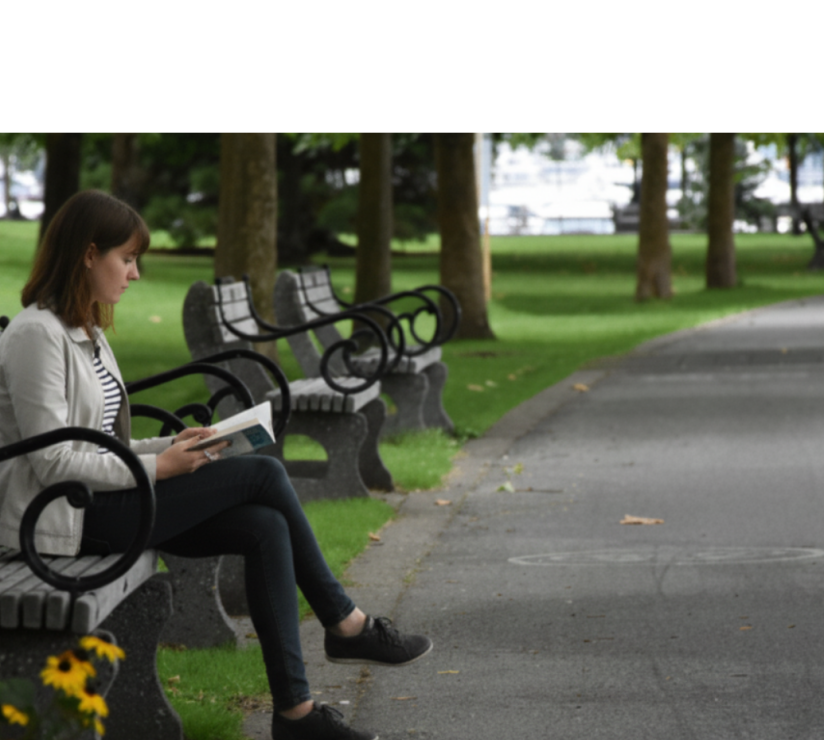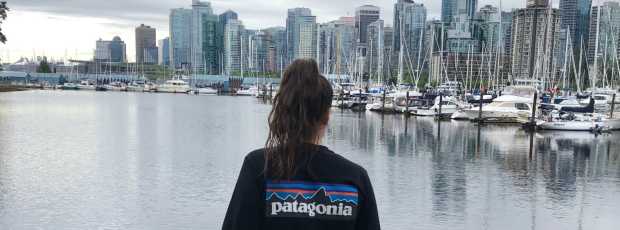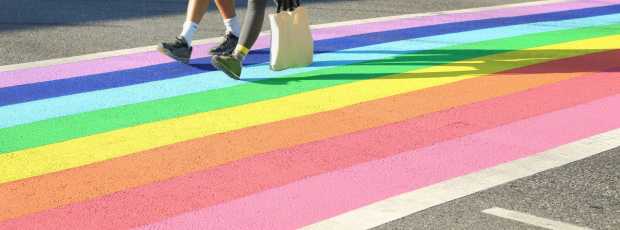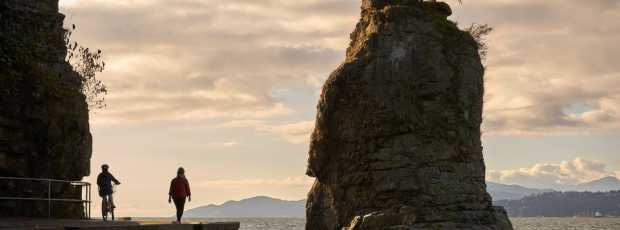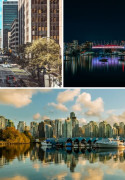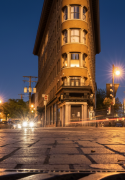Excellent. Nas was my guide. He was very flexible about changing the schedule to things that interested me specifically. Very eager to help take pictures, alter the schedule to fit in things I needed, or answer questions I had. Very knowledgeable about the city and its history.Samuel, Vancouver, 2025
Explore Vancouver like a local on a private tour
Real neighborhoods, local hangouts, your pace
Table Of Contents
- You Haven't Really Done Vancouver Without These Neighborhoods
- What Makes Vancouver's Historic Districts Different?
- Where Are Vancouver's Creative Neighborhoods?
- Which Vancouver Neighborhoods and Spots Are Best for Food?
- What Are the Best Family-Friendly Vancouver Neighborhoods?
- Where Does Vancouver Come Alive at Night?
- What Waterfront Areas Should You Explore?
- Overrated Vancouver: Keep, Tweak, or Find Alternatives
- How Do You Navigate Vancouver's Neighborhoods?
- Frequently Asked Questions
- Final Thoughts
I'm Lucas, and I've spent ten years learning Vancouver one pencil sketch at a time. Not as a tourist checking boxes, but as an artist who moved here, stayed, and built a life around observing how light falls across heritage windows and how neighborhoods reveal themselves in small details.
I carry a sketchbook everywhere. That habit has taken me from Gastown's cobblestones at dawn to Coal Harbour's seaplane docks at dusk, from Mount Pleasant's brewery patios to Kitsilano's beach-facing porches.
Through City Unscripted, I've guided visitors who arrived thinking Vancouver was just mountains and water, then left understanding how neighborhoods layer history, culture, and daily life into something you can only grasp on foot.
The best neighborhoods and Vancouver experiences don't announce themselves with tourist infrastructure or famous landmarks. They show up in tree lined streets, community gardens between apartment blocks, and the way residents move between local shops and parks without hurry.
On paper, Vancouver looks like a big city. On foot, it feels like a set of corners. Some are built from historic homes, others from apartments stacked close to services. Some sit near the North Shore Mountains, others lean toward the bay.
These neighborhoods connect through quick transit links, making them easy to fold into day trips from Vancouver or things to do when you want to understand how locals move through the city.
Here's what I've learned about where to walk, where to sketch, and which corners reveal Vancouver's true character.
Looking for a private city experience in Vancouver?
Explore the city with a local who plans a private day just for you; no groups, no scripts.
You Haven't Really Done Vancouver Without These Neighborhoods
Three neighborhoods form Vancouver's core identity. Miss these and you miss how the city balances heritage with daily life, how water shapes community, and how residential streets can feel both dense and calm.

Cobblestone street in Gastown with heritage buildings and the iconic steam clock
Gastown: Where Vancouver Started
Brick, light, and old window glass. I come early, before the crowds, for a quiet street and a table near a drafty pane. The iconic steam clock lets out its hourly puff, but I pay more attention to cornices and shadows. Gastown is one of Vancouver's oldest neighborhoods, with cobblestones underfoot and a past that shows in every wall.
Water Street runs the length of the district, lined with restaurants and shops that occupy heritage buildings from the 1890s. The neighborhood has shifted from working waterfront to tourist draw to something more balanced.
Locals return for cocktails at spots like Alibi Room, where the beer selection runs deep and the space feels more honest than polished.
Its slow mornings keep me sketching, and its mix of architecture feels lived-in rather than staged. For visitors curious about things to do in Vancouver, Gastown shows both history and lived detail in equal measure.
West End: Dense but Walkable
I call the West End my walking classroom. Apartments stand beside historic homes, and tree lined streets fold into Stanley Park. Families lean into strollers, residents carry sand on their shoes from English Bay, and grocers restock shelves under awnings. This is one of Vancouver's most densely populated districts, but it feels approachable.
Denman Street runs north-south through the neighborhood, lined with cafés, grocers, and small restaurants serving everything from sushi to Vietnamese pho. On summer evenings, I like to walk Denman with gelato, moving slowly under the maples. The city bends with the light, folding into water at the edge of English Bay.
The seawall wraps around the peninsula, step-free and wide enough for families with strollers, cyclists, and runners to share without crowding. English Bay Beach fills on summer afternoons, but early mornings belong to swimmers and dog walkers who know the rhythm.
I often sketch balconies strung with laundry or bikes tied to rails, noticing how small domestic details shape the character of a place.
Lost Lagoon's bird sanctuary sits on the park's interior, offering quieter trails through old-growth forest.
Stanley Park Seawall: The City's Living Room
Stanley Park isn't technically a neighborhood, but the seawall functions as one. I go early, before the city wakes, and let the gulls and my footsteps set the pace. Families pass in small clusters, stroller wheels soft on the path, and we trade quiet nods.
The 9-kilometer loop wraps the park's perimeter, connecting neighborhoods from Coal Harbour through the West End to Kitsilano. Totem poles near Brockton Point mark cultural heritage with First Nations art that draws visitors and locals alike. Lost Lagoon's bird sanctuary sits on the park's interior, offering quieter trails through old-growth forest.
Most visitors bike the seawall counterclockwise, but walking lets you catch details: how light moves through cedars, where cormorants dry their wings on offshore rocks, where residential towers give way to forest within steps.
What Makes Vancouver's Historic Districts Different?
Vancouver's historic neighborhoods carry their past in architecture and street layout, but they function as lived-in communities rather than preserved museums. These districts balance heritage protection with shops, restaurants, and residents who shape daily rhythm.

Entrance gate and mural in Vancouver’s Chinatown
Chinatown: Layers of Memory
I step into Dr. Sun Yat-Sen Garden for quiet, then follow Pender Street for sign paint and old tile. Murals read like a family album, each wall a story of resilience. Vancouver's Chinatown is both a historic district and a lived-in neighborhood.
Shops here carry more than services, they hold memory. Windows of herbs, bakeries with handwritten menus, and restaurants that have served generations. Bao Bei brings a modern touch to Chinese small plates, while Phnom Penh draws lines for its cult chicken wings. For cocktails after dark, The Keefer Bar mixes Chinese herbal ingredients into drinks that respect tradition without mimicking it.
I watch how the light falls on tiled facades, sketching doorframes and lanterns. The neighborhood faces pressure from development, but community advocacy keeps the district's character visible. If you want a location that connects history to present, this is my favorite and one of the clearest places to begin exploring hidden gems in Vancouver.
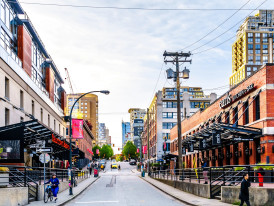
Brick warehouse turned restaurant in Yaletown
Yaletown: Rails to Residences
I really like to walk the old rail yards turned brick-and-beam lofts and slim courtyards. I still count loading bays, the way other people count steps. Patios now, but the stenciled numbers and iron rails remain. Along the seawall, apartments sit over workday shops and late patios.
Yaletown's conversion from industrial to residential happened in the 1990s, preserving warehouse bones while adding restaurants and boutiques. Blue Water Café anchors the dining scene with Pacific seafood, while Rodney's Oyster House keeps raw bar traditions simple. People move between water and city without hurry.
The little False Creek ferries knit the edges, connecting Yaletown to Granville Island and the West End in short hops that cost a few dollars. When I need proof that history and daily life share the same block, I come here and look.
Travel Guides Can Only Take You So Far
City Unscripted connects travelers with locals who shape days that actually fit your interests, not someone else’s checklist.
See how it worksWhere Are Vancouver's Creative Neighborhoods?
Creative districts emerge where affordable space meets community infrastructure. Vancouver's creative neighborhoods cluster along transit corridors east of downtown, where studio rents stay manageable and independent businesses find footing.

Main Street, Mount Pleasant
Mount Pleasant: Brewery Creek's Legacy
On Main Street, painted brick seems to shift with the light. Brewery Creek runs below ground, but its legacy lingers in craft breweries and patios where neighbors gather. I often pause to sketch how new doors meet old frames, or how a mural covers half a block in fresh paint.
Mount Pleasant is an eclectic mix, single family dwellings next to converted warehouses, studios beside small cafés. Brassneck Brewery and 33 Acres represent the neighborhood's beer culture, pouring pints in spaces that feel more like living rooms than taps. Main Street restaurants serve everything from ramen to farm-to-table dinners, with price points that stay accessible.
The neighborhood shows how residential development can layer without losing human scale. If I have to bring friends to a spot that speaks to me, this is it. It's the one that most clearly shows creativity in motion, and it connects easily to things to do in Vancouver at night when breweries and music venues open their doors.
Grandview-Woodland: Commercial Drive's Community
My friends come here more often than I do, but I try to visit whenever I have time. Commercial Drive carries layers of culture. Grocers open to sidewalks, cafés spill onto corners, and families move between schools and beautiful parks.
This is where East Vancouver feels distilled, an extensive mix of heritage houses and new builds, murals and bakeries. Italian delis share blocks with Ethiopian restaurants, Vietnamese pho shops, and Latin American grocers. The Drive, as locals call it, hosts street festivals in summer and maintains a bohemian character year-round.
Side streets hold quiet: fruit trees leaning over fences, neighbors tending small plots, kids chalking sidewalks. It feels less like a district and more like a lived rhythm that shifts between weekday routines and weekend energy.
Which Vancouver Neighborhoods and Spots Are Best for Food?
Vancouver's food culture spreads across neighborhoods rather than concentrating in a single district. The best eating follows immigrant communities, waterfront access, and independent operations that serve locals first.
Granville Island: Market as Anchor
Granville Island Public Market functions as Vancouver's food hub, connecting local producers with residents and visitors under one roof. I start here when I'm showing out-of-town friends what to eat in Vancouver means beyond restaurants.
The market operates year-round, with vendors selling smoked salmon from coastal waters, fresh produce from Fraser Valley farms, artisan breads, and prepared foods that range from dim sum to seafood chowder. The space feels lived-in rather than polished, with scuffed floors and vendor stalls that have occupied the same spots for decades.
Beyond the market, Granville Island holds breweries, art studios, and theaters, making it function as a mixed-use district accessible by Aquabus ferry from downtown or False Creek. The island works as a half-day destination or a quick stop for supplies before exploring other neighborhoods.
Richmond: Dim Sum Capital
Richmond sits south of Vancouver proper, accessible via Canada Line SkyTrain in about 25 minutes from downtown. The neighborhood holds Vancouver's densest concentration of Chinese and Asian restaurants, with dim sum parlors, hot pot restaurants, and Hong Kong-style cafés that serve local Chinese-Canadian communities.
Sun Sui Wah and Dynasty Seafood anchor the dim sum scene with weekend brunch service that draws families from across the region. Alexandra Road and No. 3 Road hold dozens of restaurants where menus run entirely in Chinese and service follows Hong Kong rhythms rather than tourist expectations.
The Richmond Night Market operates May through October, but the neighborhood's real food culture lives in year-round restaurants where locals eat daily rather than seasonal attractions designed for visitors.
Where Can You Find Authentic Sushi?
Vancouver's Japanese food scene rivals any North American city, with sushi restaurants that range from casual to ceremonial. Miku introduced aburi (flame-seared) sushi to Vancouver, serving it with harbor views from its Waterfront location. Tojo's in Fairview represents the city's sushi heritage, where chef Hidekazu Tojo has served omakase for decades.
For neighborhood sushi that locals return to weekly, Sushi by Yuji on Kingsway offers quality without ceremony, the kind of spot where you order the same roll every visit because it works.
Vancouver's sushi culture respects tradition while adapting to local ingredients: Pacific salmon, spot prawns in season (May to June), and Dungeness crab that arrives fresh from coastal waters. Don't drown your sushi in soy sauce, and trust the chef's preparation.
Hungry to Try Vancouver's Cuisine Yourself?
Taste and explore the flavors locals actually love.
What Are the Best Family-Friendly Vancouver Neighborhoods?
Family-friendly neighborhoods balance residential density with parks, schools, and services within walking distance. These areas prioritize accessibility, safety, and community infrastructure over nightlife and entertainment.
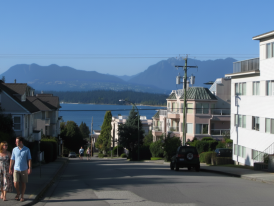
Residential Kitsilano street with single family homes and gardens
Kitsilano: Beach and Residential Balance
I read Kitsilano by its rooflines. Single family residences with small front gardens line tree-lined streets that drift toward the beach. It stays residential, windows open, salt air, the soft click of bikes at the curb.
Kitsilano Beach provides summer swimming and volleyball courts, with the Kitsilano Pool offering saltwater swimming with mountain views. 4th Avenue holds independent shops and cafés where neighbors gather for coffee, yoga classes, and weekend errands.
The neighborhood's single family dwellings and low-rise apartments create a scale that feels approachable for families with young children. Parks like Kitsilano Park and Volunteer Park offer playgrounds and green space within blocks of most homes.
When I have time I walk to the water, sketch a porch or a chimney in the park, then carry it home in my pocket. This is where you need to come if you want a feel for residential Vancouver that balances urban access with quieter streets.
Arbutus Ridge: Greenway and Gardens
Once a marsh called Asthma Flats, sand hauled from False Creek made it buildable. Today, single family residences line boulevards, and the Arbutus Greenway provides easy access for walkers and cyclists. Raised beds and community gardens run alongside, a thread of green across the city.
The greenway stretches from False Creek to the Fraser River, offering a step-free, stroller-friendly route that connects multiple neighborhoods without crossing major roads. In spring, cherry blossoms line residential streets, and the neighborhood maintains a quiet character that appeals to families seeking space without leaving the city.
This is a great place to experience what feels authentic about Vancouver without tourist infrastructure or crowds.
Where Are the Best Parks for Kids?
Beyond Stanley Park, neighborhoods throughout Vancouver maintain smaller parks with playgrounds, fields, and community centers. Kitsilano Park and Volunteer Park in Kitsilano offer beach access and open space. Guelph Park (renamed Dude Chilling Park by locals) in Mount Pleasant combines humor with function, providing a gathering spot with sculptures and green space.
Trout Lake in East Vancouver hosts a farmers market on summer Saturdays and offers swimming, playgrounds, and fields that families use year-round. Queen Elizabeth Park provides hilltop views from its central location, with gardens and conservatory that work for all ages.
Don’t Just Visit Vancouver. Feel Part of It.
Locals share their city as they live it, so even a few hours can feel like you truly belong.Where Does Vancouver Come Alive at Night?
Vancouver's nightlife spreads across multiple neighborhoods rather than concentrating in a single entertainment district. The best nights follow neighborhood character, from cocktail culture in historic districts to LGBTQ+ hubs and brewery patios.

Rainbow crosswalk in Davie Village at night
Davie Village: Vancouver's LGBTQ+ Heart
All my friends with even an ounce of photographic inclinations love Davie Village. At night, the rainbow crosswalk glows. Conversations drift from patios, and the streets hum with color. I linger on corners, sketching light against glass.
Davie Village anchors Vancouver's LGBTQ+ community, with bars, restaurants, and shops that have served the community for decades. The neighborhood's energy peaks after dark, but daylight shows another side: local shops, grocers, and services that deliver daily needs.
For me, the diversity of Davie Village isn't just about nightlife, it's about how the community keeps its rhythm across hours. Things to do in Vancouver often shine brightest here, not for spectacle but for intimacy and authentic community presence.
Gastown and Chinatown After Dark
Gastown's cocktail bars occupy heritage buildings with brick walls and tin ceilings. The Alibi Room pours craft beer in a space that feels more workshop than bar, with communal tables and a focus on British Columbia breweries. For cocktails, The Keefer Bar in Chinatown mixes drinks using Chinese herbs and traditional ingredients, creating flavor profiles that respect cultural roots.
These neighborhoods work at night because they balance locals and visitors, offering spaces where conversation matters more than volume.
Mount Pleasant Breweries: Community Pours
For evenings, I head to Davie Village or a brewery in Mount Pleasant. Softer rooms, easier conversations. Brassneck Brewery and 33 Acres represent Mount Pleasant's beer culture, serving pints in converted industrial spaces that maintain neighborhood scale.
The brewery scene here functions as community gathering spaces rather than destination drinking, with locals dropping by after work or on weekends for a beer and conversation without event pressure.
What Waterfront Areas Should You Explore?
Vancouver's waterfront neighborhoods shape how residents interact with water daily rather than treating beaches as occasional destinations. The seawall and False Creek create continuous walking and cycling routes that connect multiple districts.
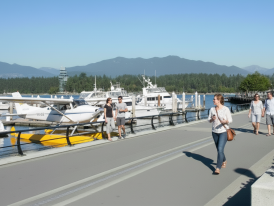
Seaplanes and towers at Coal Harbour waterfront
Coal Harbour: Seaplanes and Skyline
I like to watch seaplanes pull in as if parking in a driveway. Towers rise along the water, glass and tide sharing the view. I walk the seawall here, noting how residents move between offices and parks, how marinas mirror the skyline in calm water.
Coal Harbour developed in the 1990s and 2000s, converting industrial waterfront to residential towers with ground-floor retail. The neighborhood serves downtown workers and residents who prioritize water access and walkability over space.
The seawall continues from Stanley Park through Coal Harbour to the Convention Centre, offering step-free access for wheelchairs and strollers along the entire route. Early mornings bring runners and dog walkers, while evenings fill with residents walking home from downtown offices.
How Do the False Creek Ferries Work?
On the little False Creek ferries I take a blue seat and ride two stops for no reason except the view. The wake is short, the water folds the city inward, and for a minute everything feels close.
Aquabus and False Creek Ferries operate small passenger ferries connecting Granville Island, Yaletown, the West End, and other waterfront points. Fares run a few dollars per ride, with no schedule required, ferries depart every 5 to 15 minutes depending on time and season.
The ferries function as practical transit and scenic experience simultaneously, offering perspectives on the city's waterfront development and mountain backdrop that you can't get from streets or bridges.
Want to Experience Vancouver Firsthand?
Step into the neighborhood, scene, or story with someone who knows it inside out.
Overrated Vancouver: Keep, Tweak, or Find Alternatives
Not every famous Vancouver neighborhood delivers on its reputation. Some work better with timing adjustments, others function best when you skip the obvious and explore corners that locals actually use.
Robson Street Shopping District
Tweak: Go early morning (before 10 AM) when cruise ship crowds haven't arrived and chain stores just open their doors. Window shop quickly, then move to side streets where independent shops hold better inventory.
Alternative: Main Street between Broadway and 30th Avenue offers independent boutiques, vintage shops, and local designers without tourist crowds. Commercial Drive adds international grocers and community shops where prices reflect neighborhood use rather than visitor spending.
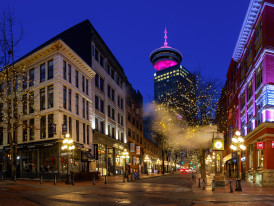
Independent shops along Main Street
Granville Street Nightlife
Tweak: If you're visiting Granville Street clubs, go mid-week before 11 PM when cover charges drop and crowds thin. Weekends turn the strip into a student party zone that feels more chaotic than fun.
Alternative: Gastown's cocktail bars and Mount Pleasant breweries offer better conversation and local atmosphere. Davie Village provides inclusive nightlife without the aggressive door policies and lineup culture that defines Granville Street after dark.
Granville Island Tourist Restaurants
Keep: The public market absolutely deserves your time, with vendors selling products you'll want to take home and prepared foods that represent local quality.
Tweak: Skip the sit-down restaurants on the island's perimeter, which serve cruise ship crowds and price accordingly. Buy from market vendors, then eat on the waterfront seawall with better views and half the cost.
Alternative: Walk 15 minutes east to South Main (between 2nd and Broadway) for restaurants that serve neighborhood regulars with better value and creativity. Mount Pleasant's Main Street holds dozens of options where locals eat weekly rather than tourists visit once.
Downtown Core for "Authentic" Experience
Alternative: Downtown Vancouver serves business and convention functions well, but neighborhood character lives in adjacent districts. Spend an hour downtown if your hotel sits there, then walk to Gastown, Chinatown, or take transit to Mount Pleasant or Commercial Drive where residential rhythm shapes street life.
The West End provides downtown proximity with actual neighborhood feeling, proving you don't need to leave the city center entirely to find authentic local life.
How Do You Navigate Vancouver's Neighborhoods?
Vancouver's transit system connects neighborhoods efficiently, with SkyTrain, buses, SeaBus, and ferries covering the region's geography. Understanding how these systems work together makes exploring multiple neighborhoods in a day manageable without a car.

SkyTrain Canada Line interior
Transit Basics: Compass Card and Zones
I use the SkyTrain, then walk. A Compass card makes transfers simple. From YVR, I take the Canada Line, reading station names like a map of the week.
The Compass Card functions as Vancouver's transit payment system, working on SkyTrain, buses, SeaBus, and West Coast Express. Purchase cards at any SkyTrain station for a refundable deposit, then load value or day passes. Transit operates on a zone system, one zone covers most Vancouver neighborhoods, two zones reach suburbs like Richmond, three zones extend to Burnaby and beyond.
Canada Line runs from YVR airport to downtown in about 25 minutes, stopping at Richmond stations along the way. Expo Line serves East Vancouver, Burnaby, and extends to Surrey. Millennium Line connects to Commercial Drive and East Vancouver neighborhoods.
SeaBus and North Shore Access
SeaBus connects Waterfront Station downtown to Lonsdale Quay in North Vancouver in 12 minutes, offering the region's most scenic commute with harbor and mountain views. Lonsdale Quay holds a public market smaller than Granville Island but serving similar functions, with local vendors and prepared foods.
From Lonsdale Quay, buses connect to North Vancouver neighborhoods, Lynn Canyon, and other North Shore destinations. The SeaBus runs every 15 to 30 minutes depending on time of day, with late-night service on weekends.
What About Accessibility and Step-Free Routes?
The seawall offers step-free access for wheelchairs and strollers along its entire waterfront route, from Stanley Park through Coal Harbour, False Creek, and continuing to Kitsilano Beach. The path stays wide and maintained year-round.
Arbutus Greenway provides another step-free route stretching from False Creek to the Fraser River, with gentle grades and smooth surfaces suitable for wheelchairs, strollers, and mobility devices. SkyTrain stations include elevators, though some older buildings in historic neighborhoods have stairs without accessible alternatives.
On sidewalks, I give space, buy from shops with hand-lettered signs, and let neighborhoods show themselves without agenda or schedule pressure.
When Should You Visit Different Neighborhoods?
Vancouver's neighborhoods shift character with seasons and festivals. Cherry blossoms bloom throughout residential streets in late March and April, with peak viewing along tree-lined streets in Kitsilano, Arbutus Ridge, and throughout the West End.
Dine Out Vancouver runs through January and February, offering prix-fixe menus at restaurants throughout the city. The Richmond Night Market operates May through October on weekends, while the Celebration of Light brings fireworks to English Bay in summer, drawing crowds to West End beaches.
Rainy days (common October through March) work well for covered markets like Granville Island, museum visits, or café hopping in Mount Pleasant where you can duck between shops without getting soaked.
Frequently Asked Questions
1) Which Vancouver neighborhoods are most walkable?
West End, Gastown, Yaletown, and Main Street in Mount Pleasant offer the highest walkability, with shops, restaurants, and services within blocks of residential areas. These neighborhoods maintain human-scale streets where walking feels natural rather than necessary.
2) What are the safest Vancouver neighborhoods at night?
Yaletown, Coal Harbour, Kitsilano, and the West End maintain active street life and good lighting after dark. Gastown and Davie Village stay busy with restaurant and bar traffic. I do not tour the Downtown Eastside. I pass with respect, camera down, and I recommend you do too.
3) Which neighborhoods work best for families with kids?
Kitsilano, Arbutus Ridge, and parts of the West End offer parks, schools, and residential streets within walking distance of services. These neighborhoods prioritize accessibility and community infrastructure over nightlife and entertainment.
4) Where are Vancouver's most affordable neighborhoods?
East Vancouver neighborhoods along Commercial Drive and around Main Street offer more affordable housing and dining compared to downtown or waterfront districts. Richmond provides access to authentic food at lower prices than tourist-focused areas.
5) Which Vancouver neighborhoods have the best views?
Coal Harbour and Yaletown provide harbor and mountain views from the seawall. Kitsilano offers beach perspectives looking back toward downtown. Queen Elizabeth Park sits on the city's highest point, with panoramic views across the region from its central location.
6) What are the best rainy-day neighborhoods?
Mount Pleasant and Commercial Drive work well in rain, with covered bus stops and shops close together for ducking between cafés and boutiques. Granville Island's covered market provides shelter while browsing. Yaletown's heritage awnings offer some protection along loading bay streets.
7) Where can you find authentic markets?
Granville Island Public Market operates year-round with local producers and prepared foods. Lonsdale Quay in North Vancouver serves similar functions on a smaller scale. Trout Lake Farmers Market runs summer Saturdays in East Vancouver with seasonal produce and artisan vendors.
8) How does parking work in Vancouver neighborhoods?
Most residential neighborhoods offer street parking with meters or time limits. Downtown, Yaletown, and Gastown charge hourly rates ($3 to $6 per hour). Kitsilano and Mount Pleasant offer easier free parking on side streets, though availability varies by time and day. Transit works better than driving for most neighborhood exploration.
9) Which neighborhoods have beach access?
West End connects to English Bay Beach and Second Beach in Stanley Park. Kitsilano provides Kitsilano Beach and pool access. Spanish Banks and Jericho Beach sit west of Kitsilano, offering quieter waterfront with mountain views. All beaches maintain accessibility features and summer lifeguard service.
10) Where is Vancouver's LGBTQ+ hub?
Davie Village serves as Vancouver's primary LGBTQ+ neighborhood, with bars, restaurants, and community services clustered along Davie Street between downtown and the West End. The rainbow crosswalk marks the neighborhood's heart, and the community maintains year-round presence and events.
11) What seasonal events shape neighborhood character?
Cherry blossoms transform residential streets in spring (late March to April). The Richmond Night Market operates May through October. Canada Day (July 1) brings celebrations to beaches and parks. The Celebration of Light fireworks series fills English Bay beaches in summer. Dine Out Vancouver runs through January and February with restaurant participation citywide.
12) How do you get from YVR airport to neighborhoods?
Canada Line SkyTrain connects YVR to downtown in 25 minutes, with stops at Richmond stations along the way. From downtown, transfer to other SkyTrain lines or buses for neighborhoods throughout the city. A taxi or rideshare to downtown costs $30 to $40, though transit costs under $10 with a Compass Card.
13) Which neighborhood should first-time visitors prioritize?
Start with Gastown for historic context, walk the seawall through Stanley Park to the West End, then take False Creek ferries to Granville Island for market browsing. This route covers waterfront, heritage, and food culture in a half-day without requiring transit beyond the ferry. Save Mount Pleasant and Commercial Drive for a second day when you want neighborhood rhythm over iconic sights.
14) Where do locals actually shop and eat?
I choose Main Street over Robson, Commercial Drive over Granville Street, and Richmond's Alexandra Road restaurants over tourist districts. New Town Bakery, The Fish Counter, HK BBQ Master, and Ask for Luigi represent neighborhood spots where locals return weekly rather than visitors tick boxes once.
15) What makes Vancouver neighborhoods different from other cities?
Water shapes everything. The seawall connects neighborhoods continuously, ferries function as transit, and mountain views anchor orientation from every district. Residential density stays high without feeling overwhelming because parks, beaches, and greenways thread between buildings. You can live in an apartment tower and walk to old-growth forest within 10 minutes.
Final Thoughts
Most days I do not plan. A ferry, a side street, a coffee, and a sketchbook page. The city fills the rest.
Vancouver may look like a big city, but it reveals itself in corners: one porch, one mural, one park at a time. In these details, Vancouver neighborhoods show their unique character, making Vancouver not just a city to see but a city to live, slowly and with intent.
When it rains I choose a window table and sketch. Pencil on cheap paper, coffee cooling beside me, cornices turning into lines until the page fills, then one more line for luck. These small rituals form my ongoing Vancouver experience, and they're available to anyone willing to walk slowly and notice how light changes across heritage windows.

Quiet residential street with houses and trees
If you want to understand how these neighborhoods connect into lived experience rather than tourist itinerary, consider exploring with a local host who can show you the corners that don't appear in guidebooks. Through City Unscripted, I've shared these streets with visitors who arrived thinking they knew Vancouver and left with sketchbooks full of details they didn't expect to find.
For me, these small details remain the most authentic part of any Canadian experiences. The best neighborhoods reward curiosity over agenda, patience over schedule, and walking over any other way of seeing.
More Vancouver For You
Ready to plan your perfect day in Vancouver?
Start your experienceWhat If Exploring a City Felt More Personal?
City Unscripted pairs you with someone who lives there, so you can see iconic sights and hidden corners in a way that feels like yours.
Wish you had a local friend in Vancouver?
One who knows the city inside out and could plan a private day just for you? Our local hosts do exactly that: no scripts, no tourist traps, just the side of the city most people miss.
